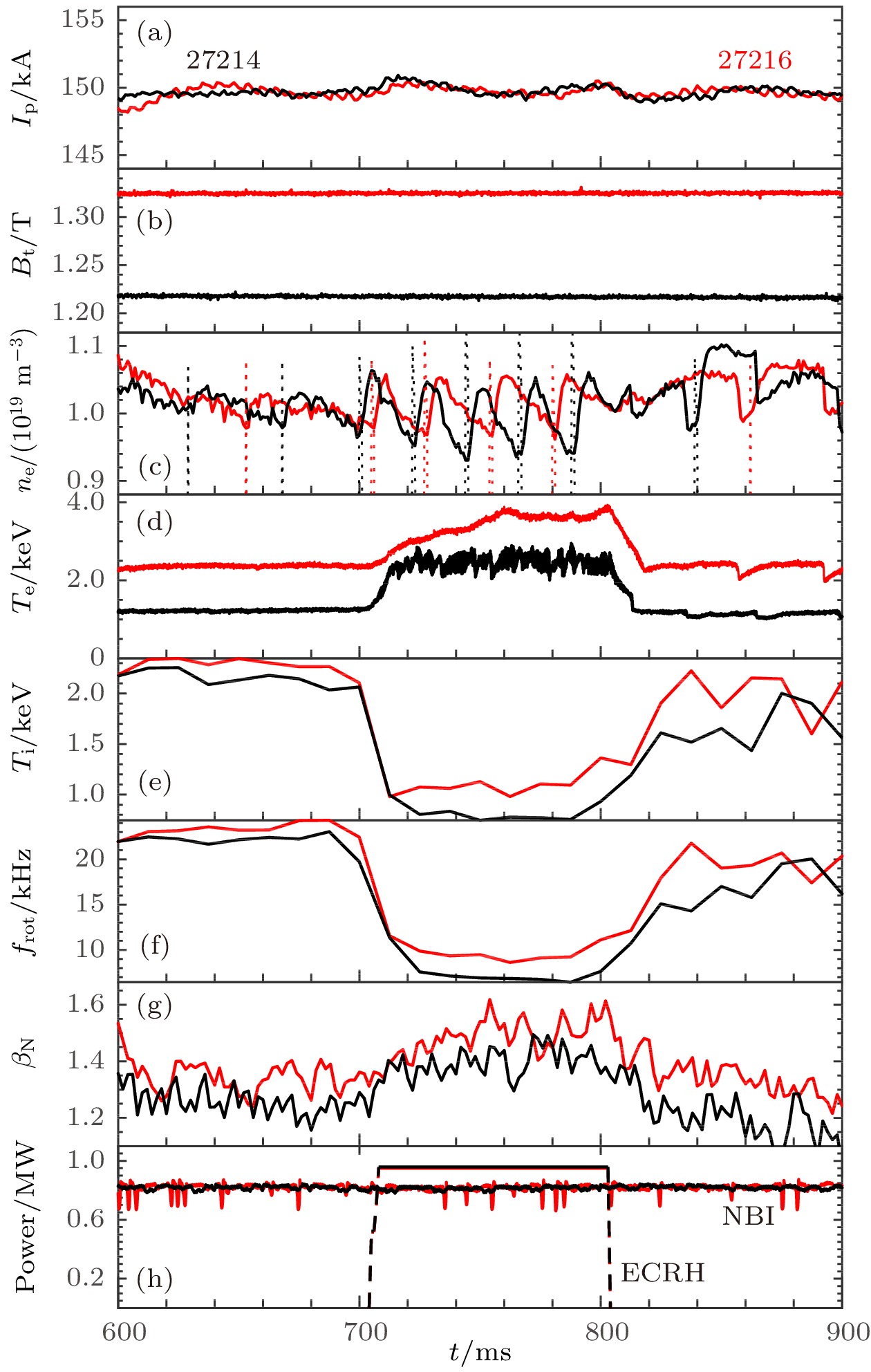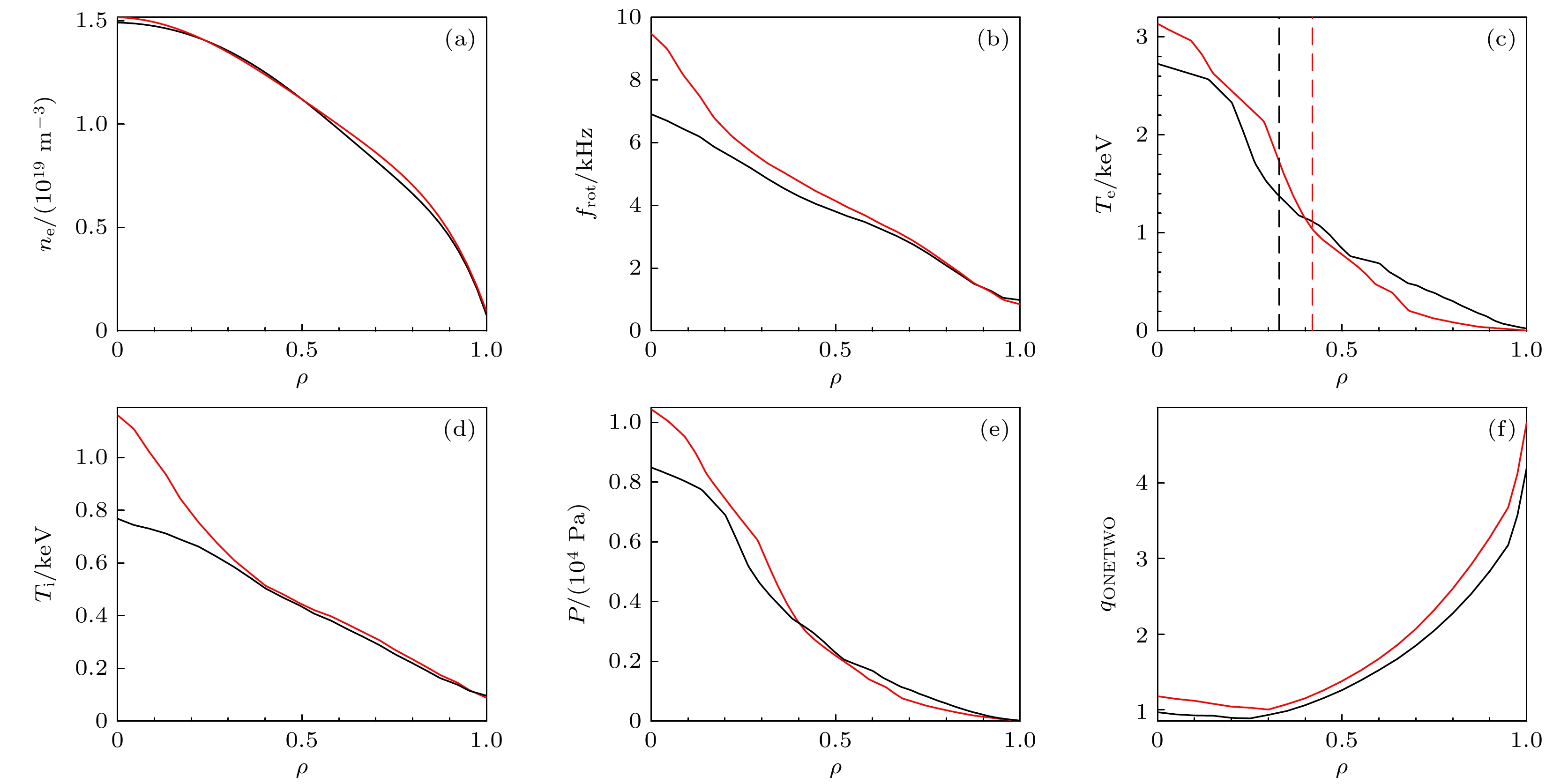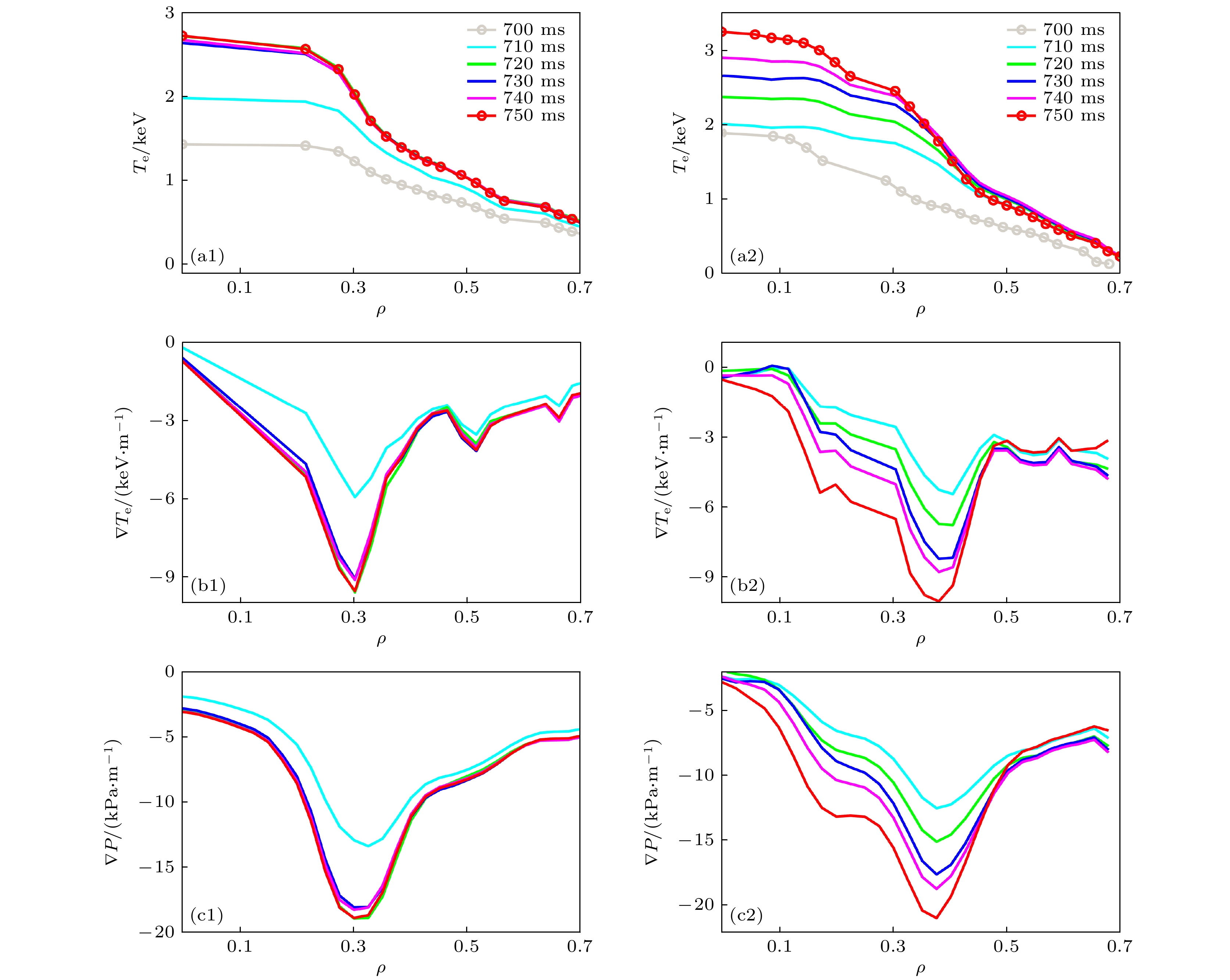-
Experiment on suppressing fishbone activities is carried out in HL-2A tokamak by electron cyclotron resonance heating (ECRH). To achieve multiple deposition locations of ECRH, the magnetic field is in a range of 1.22–1.4 T from shot to shot. It is found that the fishbone modes exhibit different characteristics at different radial deposition locations. With the same injected power, the effect of off-axis ECRH is much better than that of on-axis heating. The fishbone modes can be completely suppressed when ECRH is deposited nearby the q = 1 rational surface, but would only mitigate in other cases. Further analysis indicate that injection of high power ECRH leads the electron temperature to increase, then the pressure gradient and plasma current density to change, finally safety factor to change and the minimum safety factor to reach a value larger than 1. Meanwhile, M3D-K simulation results show that the growth rate of fishbone mode declines with the increase of qmin. In other words, the growth of safety factor and disappearance of q = 1 rational surface induced by ECRH contribute to the suppression of fishbone activities. The experimental results reported here may not only help to better understand complex effects of ECRH on magnetohydrodynamic instability, but also provide a physics basis for actively controlling the energetic particle driven modes in the future magnetic confined fusion devices.
-
Keywords:
- electron cyclotron resonance heating /
- deposition location /
- active control /
- fishbone modes
[1] McGuire K, Goldston R, Bell M, et al. 1983 Phys. Rev. Lett. 50 891
 Google Scholar
Google Scholar
[2] Chen L, White R B, Rosenbluth M N 1984 Phys. Rev. Lett. 52 1122
 Google Scholar
Google Scholar
[3] Heidbrink W W, Sager G 1990 Nucl. Fusion 30 1015
 Google Scholar
Google Scholar
[4] Nave M F F, Campbell D J, Joffrin E, et al. 1991 Nucl. Fusion 31 697
 Google Scholar
Google Scholar
[5] Zonca F, Chen L, Botrugno A, et al. 2009 Nucl. Fusion 49 085009
 Google Scholar
Google Scholar
[6] Wong K L, Chu M S, Luce T C, et al. 2000 Phys. Rev. Lett. 85 996
 Google Scholar
Google Scholar
[7] Yu L M, Ding X T, Chen W, et al. 2013 Nucl. Fusion 53 053002
 Google Scholar
Google Scholar
[8] Perez von Thun C, Perona A, Johnson T, et al. 2010 Nucl. Fusion 50 084009
 Google Scholar
Google Scholar
[9] Perez von Thun C, Salmi A, Perona A, et al. 2012 Nucl. Fusion 52 094010
 Google Scholar
Google Scholar
[10] Kiptily V G, Fitzgerald M, Goloborodko V, et al. 2018 Nucl. Fusion 58 014003
 Google Scholar
Google Scholar
[11] Anderson D, Elevant T, Hamnén H, et al. 1993 Fusion Sci. Tech. 23 5
 Google Scholar
Google Scholar
[12] Hender T C, Buratti P, Casson F J, et al. 2016 Nucl. Fusion 56 066002
 Google Scholar
Google Scholar
[13] Fredrickson E D, Belova E V, Battaglia D J, et al. 2017 Phys. Rev. Lett. 118 265001
 Google Scholar
Google Scholar
[14] Bortolon A, Heidbrink W W, Kramer G J, et al. 2013 Phys. Rev. Lett. 110 265008
 Google Scholar
Google Scholar
[15] Maslovsky D, Levitt B, Mauel M E, et al. 2003 Phys. Rev. Lett. 90 185001
 Google Scholar
Google Scholar
[16] Nagaoka K, Ido T, Ascasíbar E, et al. 2013 Nucl. Fusion 53 072004
 Google Scholar
Google Scholar
[17] Van Zeeland M A, Heidbrink W W, Nazikian R, et al. 2009 Nucl. Fusion 49 065003
 Google Scholar
Google Scholar
[18] Van Zeeland M A, Heidbrink W W, Sharapov S E, et al. 2016 Nucl. Fusion 56 112007
 Google Scholar
Google Scholar
[19] Yamamoto S, Nagasaki K, Kobayashi S, et al. 2017 Nucl. Fusion 57 126065
 Google Scholar
Google Scholar
[20] Chen W, Yu L M, Shi P W, et al. 2018 Nucl. Fusion 58 014001
 Google Scholar
Google Scholar
[21] Shi P W, Chen W, Duan X R 2021 Chin. Phys. Lett. 38 035202
 Google Scholar
Google Scholar
[22] Seol J, Lee S G, Park B H, et al. 2012 Phys. Rev. Lett. 109 195003
 Google Scholar
Google Scholar
[23] Shi P W, Zhu X L, Liang A S, et al. 2022 Nucl. Fusion 62 106009
 Google Scholar
Google Scholar
[24] Wei W, Li M H, Wang X J 2018 Nucl. Fusion Plasma Phys. 38 144
 Google Scholar
Google Scholar
[25] Chen W, Ding X T, Yu L M, et al. 2010 Nucl. Fusion 50 084008
 Google Scholar
Google Scholar
[26] Berk H L, Borba, D N, Breizman B N, et al. 2001 Phys. Rev. Lett. 87 185002
 Google Scholar
Google Scholar
[27] Shi P W, Yang Y R, Chen W, et al. 2022 Chin. Phys. Lett. 39 105201
 Google Scholar
Google Scholar
[28] Shi P W, Chen W, Shi Z B, et al. 2019 Nucl. Fusion 59 066015
 Google Scholar
Google Scholar
[29] Chen W, Yu L M, Liu Y, et al. 2014 Nucl. Fusion 54 104002
 Google Scholar
Google Scholar
[30] Yang Y R, Chen W, Ye M Y, et al. 2020 Nucl. Fusion 60 106012
 Google Scholar
Google Scholar
[31] Chen W J, Ma Z W, Zhang H W, et al. 2022 Plasma Sci. Tech. 24 035101
 Google Scholar
Google Scholar
[32] Yu L M, Chen W, Jiang M, et al. 2017 Nucl. Fusion 57 036023
 Google Scholar
Google Scholar
[33] Chen L, Zonca F 2016 Rev. Mod. Phys. 88 015008
 Google Scholar
Google Scholar
[34] Chen W, Wang Z X 2020 Chin. Phys. Lett. 37 125001
 Google Scholar
Google Scholar
[35] Heidbrink W W 2002 Phys. Plasmas 9 2113
 Google Scholar
Google Scholar
-
图 1 HL-2A 装置第27214次(黑)和第27216次(红)放电的实验参数 (a)等离子体电流; (b)环向磁场; (c)电子线平均密度(实线)及反馈送气电压信号(点线); (d)电子温度; (e)离子温度; (f)旋转频率; (g)等离子体比压; (h)中性束注入功率(实线)和电子回旋共振加热功率(虚线)
Figure 1. History evolution of basic parameters during the 27214 and 27216 discharges on HL-2A tokamak: (a) Plasma current; (b) toroidal magnetic field; (c) line-averaged electron density (solid) and voltage signal of gas puffing (dot); (d) electron temperature; (e) ion temperature; (f) rotation frequency; (g) plasma beta; (h) power of NBI and ECRH
图 5 第27214次(黑)和27216次(红)放电750 ms 时刻的平衡参数剖面 (a)电子密度
$ n_{\rm{e}} $ ; (b)旋转频率$ f_{{\rm{rot}}} $ ; (c)电子温度$ T_{\rm{e}} $ , 虚线为电子温度内部输运垒的根部位置; (d)离子温度$ T_{\rm{i}} $ ; (e)等离子体压强$ P=n_{\rm{e}}(T_{\rm{e}}+T_{\rm{i}})K $ , K为开尔文常数; (f)安全因子Figure 5. Basic profiles at 750 ms for the 27124 (black) and 27216 (red) discharges: (a) Electron density
$ n_{\rm{e}} $ ; (b) plasma rotation frequency$ f_{{\rm{rot}}} $ ; (c) electron temperature$ T_{\rm{e}} $ , the dotted lines indicate locations of internal transport barrier in electron temperature; (d) ion temperature$ T_{\rm{i}} $ ; (e) plasma pressure$ P=n_{\rm{e}}(T_{\rm{e}}+T_{\rm{i}})K $ , K is the Kelvin constant; (f) safety factor图 6 第27214 (a)和27216 (b)次放电过程中750 ms 时刻归一化压强梯度(
$ R/L_{\rm{P}} $ , 红)、电子温度梯度($ R/L_{T_{\rm{e}}} $ , 黑)、离子温度梯度(R/$ L_{T_{\rm{i}}} $ , 蓝)和电子密度梯度($ R/L_{n_{\rm{e}}} $ , 绿)的特征长度Figure 6. Normalized scale length of pressure gradient (
$ R/L_{\rm{P}} $ , red), electron temperature gradient ($ R/L_{T_{\rm{e}}} $ , black), ion temperature gradient ($ R/L_{T_{\rm{i}}} $ , blue), electron density gradient ($ R/L_{n_{\rm{e}}} $ , green) at 750 ms for the 27214 (a) and 27216 (b) discharges.图 8 (a)具有不同最小值的安全因子分布, 其中蓝色曲线为第27214次放电750 ms时刻的安全因子分布, 上下方两曲线的偏移量分别为
$ \Delta q=0.09 $ ,$ \Delta q=0.06 $ ,$ \Delta q=-0.02 $ ,$ \Delta q=-0.05 $ ; (b)鱼骨模增长率与最小安全因子的关系Figure 8. (a) Safety factor profiles with different minimum safety factors, the blue one is the safety factor profile at 750 ms for the 27214 discharge, the two upper and below curves are the safety factors with a offset of
$ \Delta q=0.09 $ ,$ \Delta q=0.06 $ ,$ \Delta q=-0.02 $ ,$ \Delta q=-0.05 $ ; (b) relationship between the growth rate of fishbone mode and minimum safety factors. -
[1] McGuire K, Goldston R, Bell M, et al. 1983 Phys. Rev. Lett. 50 891
 Google Scholar
Google Scholar
[2] Chen L, White R B, Rosenbluth M N 1984 Phys. Rev. Lett. 52 1122
 Google Scholar
Google Scholar
[3] Heidbrink W W, Sager G 1990 Nucl. Fusion 30 1015
 Google Scholar
Google Scholar
[4] Nave M F F, Campbell D J, Joffrin E, et al. 1991 Nucl. Fusion 31 697
 Google Scholar
Google Scholar
[5] Zonca F, Chen L, Botrugno A, et al. 2009 Nucl. Fusion 49 085009
 Google Scholar
Google Scholar
[6] Wong K L, Chu M S, Luce T C, et al. 2000 Phys. Rev. Lett. 85 996
 Google Scholar
Google Scholar
[7] Yu L M, Ding X T, Chen W, et al. 2013 Nucl. Fusion 53 053002
 Google Scholar
Google Scholar
[8] Perez von Thun C, Perona A, Johnson T, et al. 2010 Nucl. Fusion 50 084009
 Google Scholar
Google Scholar
[9] Perez von Thun C, Salmi A, Perona A, et al. 2012 Nucl. Fusion 52 094010
 Google Scholar
Google Scholar
[10] Kiptily V G, Fitzgerald M, Goloborodko V, et al. 2018 Nucl. Fusion 58 014003
 Google Scholar
Google Scholar
[11] Anderson D, Elevant T, Hamnén H, et al. 1993 Fusion Sci. Tech. 23 5
 Google Scholar
Google Scholar
[12] Hender T C, Buratti P, Casson F J, et al. 2016 Nucl. Fusion 56 066002
 Google Scholar
Google Scholar
[13] Fredrickson E D, Belova E V, Battaglia D J, et al. 2017 Phys. Rev. Lett. 118 265001
 Google Scholar
Google Scholar
[14] Bortolon A, Heidbrink W W, Kramer G J, et al. 2013 Phys. Rev. Lett. 110 265008
 Google Scholar
Google Scholar
[15] Maslovsky D, Levitt B, Mauel M E, et al. 2003 Phys. Rev. Lett. 90 185001
 Google Scholar
Google Scholar
[16] Nagaoka K, Ido T, Ascasíbar E, et al. 2013 Nucl. Fusion 53 072004
 Google Scholar
Google Scholar
[17] Van Zeeland M A, Heidbrink W W, Nazikian R, et al. 2009 Nucl. Fusion 49 065003
 Google Scholar
Google Scholar
[18] Van Zeeland M A, Heidbrink W W, Sharapov S E, et al. 2016 Nucl. Fusion 56 112007
 Google Scholar
Google Scholar
[19] Yamamoto S, Nagasaki K, Kobayashi S, et al. 2017 Nucl. Fusion 57 126065
 Google Scholar
Google Scholar
[20] Chen W, Yu L M, Shi P W, et al. 2018 Nucl. Fusion 58 014001
 Google Scholar
Google Scholar
[21] Shi P W, Chen W, Duan X R 2021 Chin. Phys. Lett. 38 035202
 Google Scholar
Google Scholar
[22] Seol J, Lee S G, Park B H, et al. 2012 Phys. Rev. Lett. 109 195003
 Google Scholar
Google Scholar
[23] Shi P W, Zhu X L, Liang A S, et al. 2022 Nucl. Fusion 62 106009
 Google Scholar
Google Scholar
[24] Wei W, Li M H, Wang X J 2018 Nucl. Fusion Plasma Phys. 38 144
 Google Scholar
Google Scholar
[25] Chen W, Ding X T, Yu L M, et al. 2010 Nucl. Fusion 50 084008
 Google Scholar
Google Scholar
[26] Berk H L, Borba, D N, Breizman B N, et al. 2001 Phys. Rev. Lett. 87 185002
 Google Scholar
Google Scholar
[27] Shi P W, Yang Y R, Chen W, et al. 2022 Chin. Phys. Lett. 39 105201
 Google Scholar
Google Scholar
[28] Shi P W, Chen W, Shi Z B, et al. 2019 Nucl. Fusion 59 066015
 Google Scholar
Google Scholar
[29] Chen W, Yu L M, Liu Y, et al. 2014 Nucl. Fusion 54 104002
 Google Scholar
Google Scholar
[30] Yang Y R, Chen W, Ye M Y, et al. 2020 Nucl. Fusion 60 106012
 Google Scholar
Google Scholar
[31] Chen W J, Ma Z W, Zhang H W, et al. 2022 Plasma Sci. Tech. 24 035101
 Google Scholar
Google Scholar
[32] Yu L M, Chen W, Jiang M, et al. 2017 Nucl. Fusion 57 036023
 Google Scholar
Google Scholar
[33] Chen L, Zonca F 2016 Rev. Mod. Phys. 88 015008
 Google Scholar
Google Scholar
[34] Chen W, Wang Z X 2020 Chin. Phys. Lett. 37 125001
 Google Scholar
Google Scholar
[35] Heidbrink W W 2002 Phys. Plasmas 9 2113
 Google Scholar
Google Scholar
Catalog
Metrics
- Abstract views: 6170
- PDF Downloads: 93
- Cited By: 0















 DownLoad:
DownLoad:


































